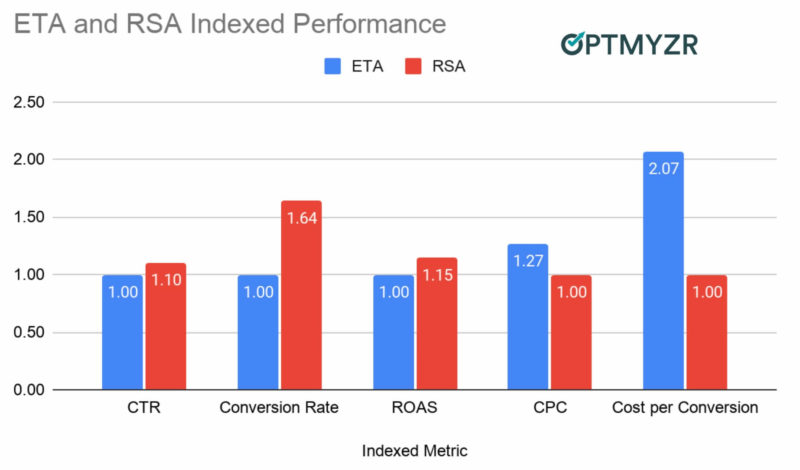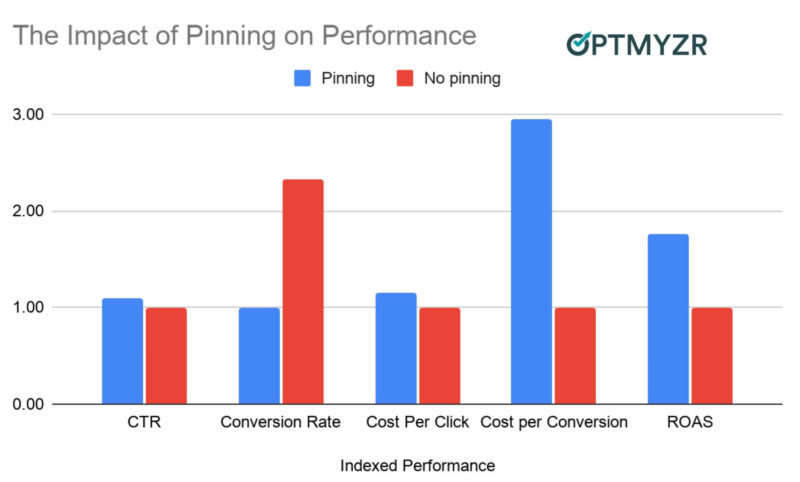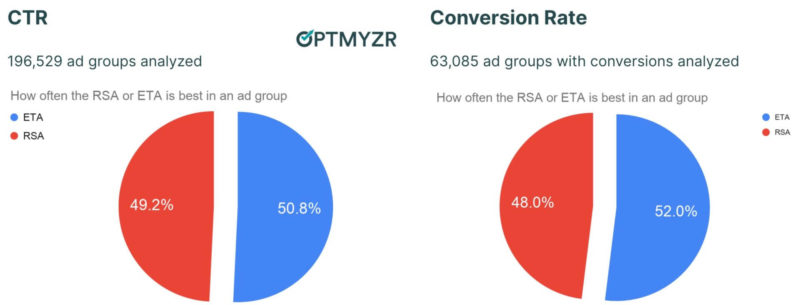RSAs vs ETAs, how, when, and why PPC experts use them
An analysis of more than 5,600 Google Ads accounts.
Brad Geddes and I recently debated whether Responsive Search Ads (RSAs) or Expanded Text Ads (ETAs) are better during our SMX session this month with Ginny Marvin.
When I agreed to debate the superiority of Responsive Search Ads (RSAs) and Expanded Text Ads (ETAs) at SMX with Ginny and Brad, I knew I needed to show up prepared.
And what research could be better than digging into the results of the work of some of the world’s most clever PPC experts? So, I asked my team at Optmyzr to dive into our usage data to help answer this question.
If you missed SMX and my discussion with Brad and Ginny, or just want to get a closer look at what I shared, we’ll cover Optmyzr’s findings below.
Most advertisers have tried RSAs and continue to use them
We analyzed a random sample of 5,606 Google Ads accounts managed with Optmyzr and found that ~75% of accounts had active RSAs. This is similar to data Brad’s team had seen in previous research. It tells us that many advertisers have explored RSAs and added at least a few of them to their accounts.
But what happens when advertisers try RSAs? In less than half a percent of all the accounts we analyzed were all the RSAs paused or deleted. So, most advertisers who add RSAs to an account end up keeping at least some of them active. This tells us that many advertisers are, at some level, satisfied with the performance of RSAs. At the very least, results were not bad enough to the point that they decided to give up on RSAs altogether.

RSAs outperform ETAs, on average
As a general rule, I don’t like averages and I don’t think advertisers should use them to make decisions. Everyone should test things for themselves, in their own accounts, and do as much as possible to optimize the performance.
That said, however, when we looked at the averages for the 5,606 analyzed accounts, RSAs beat ETAs on the main Google Ads metrics.
Note that these metrics don’t include profitability or revenue, which are the ultimate metrics advertisers should care about. For example, while RSAs had a lower cost per conversion, there is no data in our study about the ultimate quality of these conversions and whether these represented high lifetime value (LTV) leads.
What we can take away from this data is that RSAs can perform well. This finding adds credibility to the earlier fact that we see so many advertisers who’ve tried RSAs stick with them to varying degrees.

More relevant RSAs will perform better
By now you’ve probably picked up on the fact that I don’t mind RSAs at all. But, since I shared this data during a debate, it stands to reason that there is a counter-argument that I have not represented. Part of the reason our research highlights the positives of RSAs is that there’s a selection bias in our data.
We’re only considering accounts that are managed through Optmyzr where advertisers are more likely to use optimization tools to better optimize ads. As a valuable counterpoint, Brad Geddes shared a great example of a reason RSAs could underperform for some advertisers. In his example, advertisers sometimes hastily create a single generic RSA and copy-paste it across their entire account.
Advertisers who spend time creating more relevant RSAs and include text relevant to the keywords and search terms of the ad group will likely perform better. Optmyzr has an RSA Builder tool that makes it easy to create relevant RSAs from existing ETAs, which explains part of the bias where our data comes primarily from advertisers with better-than-average RSAs.
Pinning ad components hurts performance
If you’re in an industry where your ad must contain certain pieces of text in very specific locations, pin away! But if it’s not required, we found that attempting to control the machine by telling it what text to pin to certain ad positions was usually detrimental to results.
In our analysis, we looked at ads with at least one pinned component and compared them to ads with no pinned components. Ads without pinning did better on CTR, conversion rate, CPC and CPA. But the opposite was true for ROAS where ads with a pinned component did better.
Does that mean pinning is recommended for e-commerce advertisers? I’m not willing to make that claim because I can’t explain why that’d be the case.
Remember that the point of RSAs is that Google’s machine learning can construct an ad on the fly that is more likely to do well in each ad auction (for every search). It makes sense that limiting the machine’s ability by pinning things could make it less effective.
But, as I explained in my book Digital Marketing in an AI World, results are better when machines and humans collaborate. In the case of RSAs, we should focus on creating better and more relevant ad components and let the machines figure out how to combine these human-authored texts.

RSAs and ETAs can both be the best ad
I already made the point that you shouldn’t rely on averages presented by experts to make your final decision about using RSAs in your own account. But, more than that, you shouldn’t even use results from a test in a single campaign to decide what to do in the rest of that account.
When we analyzed around 200,000 ad groups that had both RSAs and ETAs, we found a near even split between which ad format was best for a particular metric. This was the case for CTR, conversion rate, CPC, CPA and ROAS.

So, if the data says it’s equally likely an RSA or an ETA is the best in an ad group, how do we explain the earlier finding that RSAs outperformed ETAs on average? Our data shows when an RSA is the better ad, it tends to be better by a wider margin compared to instances when the ETA was the better ad.
Conclusion
Brad, Ginny, and I framed our analysis of RSAs vs ETAs as a debate at SMX, but ultimately agreed to call it a tie. This was not an instance of surface-level diplomacy. Like so many things in Google Ads, the answer is usually quite complicated and will vary for each advertiser.
In fact, the answer can often vary on each query.
Here is an important takeaway: RSAs are capable of being great ads and they deserve a chance in any account. They’re not a magic wand for ad optimization and still require human optimization. And, to do that well, we are hoping Google will expose more data about RSAs so all of us, a group of motivated PPC pros, can roll up our sleeves and work our own magic on RSAs like we have for years on ETAs.
In the future, how well we do PPC will be defined by how cleverly we combine the best skills of the machines with our own human strengths — to unlevel the playing field and tip it back in our favor.
Contributing authors are invited to create content for Search Engine Land and are chosen for their expertise and contribution to the search community. Our contributors work under the oversight of the editorial staff and contributions are checked for quality and relevance to our readers. The opinions they express are their own.
Related stories